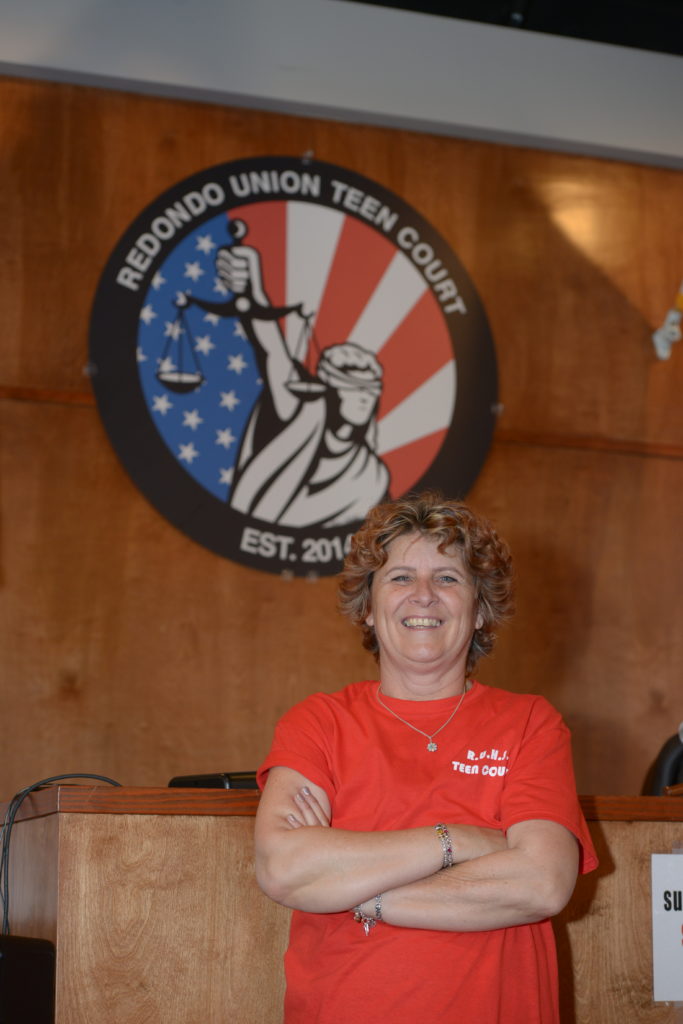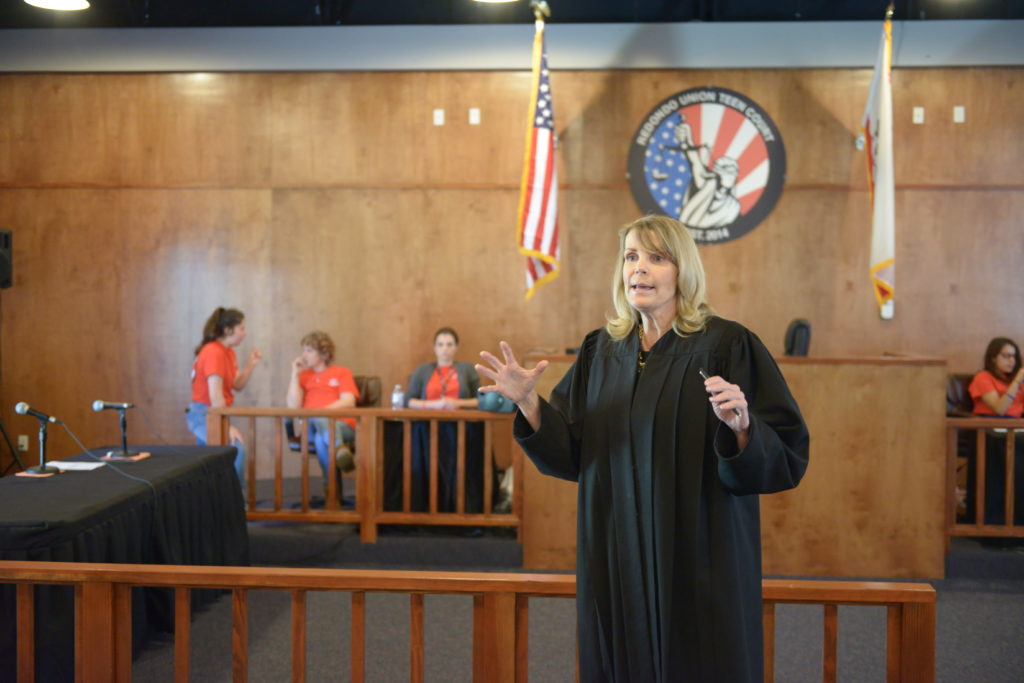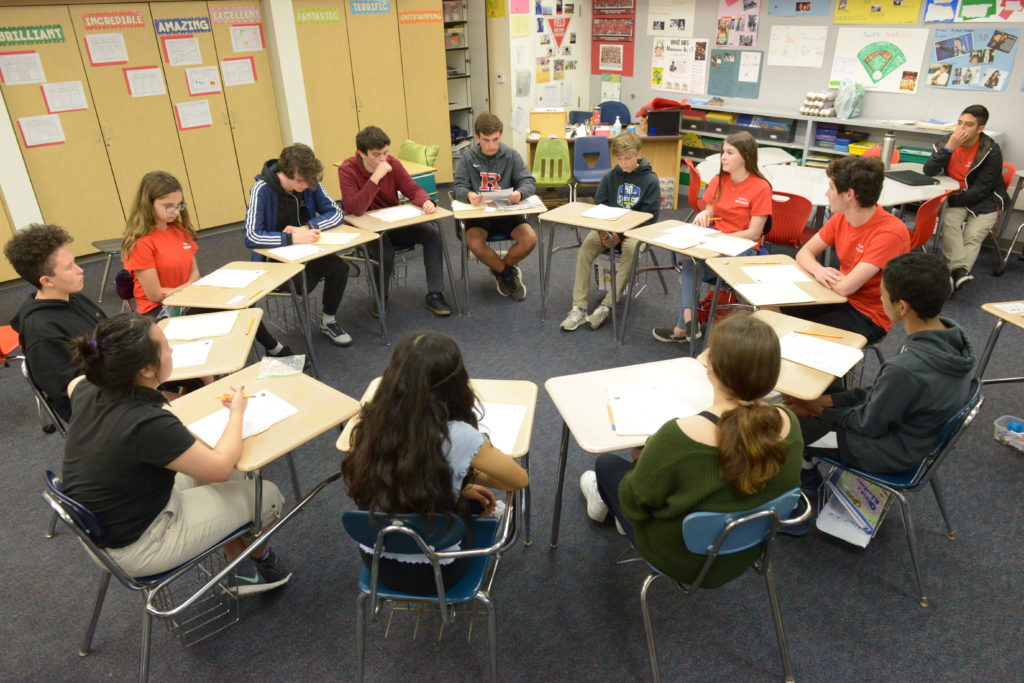Photos by Scott Buschman
The 17-year-old was out with friends at a department store when she succumbed to peer pressure. She grabbed a handful of rings from the jewelry display case along with several pairs of socks, and stuffed them into her purse without paying. Upon exiting the store, she was stopped by a security guard, arrested and charged with petty theft.
Now, a few months later, she is being judged by a jury of
her peers at Redondo Union High School’s Teen Court. The campus bingo room,
which looks like a real courtroom, is packed with students, some of whom are
called to jury duty. Unlike real life, they don’t have to wait around for
hours. They immediately step up to the jury box.
This live juvenile court has been a monthly occurrence on
campus for five years, thanks to Marie Botchie, a special education teacher who
serves as Teen Court coordinator.

“It’s a wonderful program,” says Botchie, a member of the
Redondo Beach Teachers Association. “What I love the most is that it’s a
restorative justice program instead of a punitive one. Our goal is to take kids
who have made mistakes and turn them around, so they can be a strong member of
their school and community — without becoming repeat offenders.”
Only first-time offenders are assigned to Teen Court.
Misdemeanor cases may include vandalism, assault and battery, sexual
harassment, reckless driving, and drug abuse.
The accused come from different high schools throughout the
Los Angeles area and are only identified by their first name. Before
proceedings begin, it must be determined that none of the jurors know the
accused and vice versa.
Students serving as jurors ask questions of the accused,
deliberate to determine guilt or innocence, and make sentencing
recommendations. Jurors have found students innocent on occasion. For example,
a student was accused of battery for placing a hot metal object on another
student at a party, but when jurors learned it was a game and no coercion was
involved, they found him not guilty.
To get a fuller picture of the accused, jurors can ask about
their grades, whether they abuse drugs, their plans for the future, and hobbies
or sports they enjoy.
Often, they will recommend community service aligned with
the offender’s interests, such as working in an after-school art program if
they enjoy art or receiving mentoring in a subject they are interested in for a
career.
“The goal is to get student offenders involved in positive
activities instead of taking things away from them,” says Botchie. “We want to
add good things to their lives.”
Botchie created a training program for Teen Court
participants at her school, who can fulfill requirements for government class
or community service through participation. She estimates that 500 students per
year are involved in the proceedings. Botchie also sponsors a Teen Court Club.
“The kids love it,” she says. “There is no place else where
kids who aren’t old enough to vote can be so involved in government. And these
are not mock trial cases; they are real. These jurors live very similar lives
to the accused. It’s the truest jury of peers you can ever imagine.”

There is always a judge to oversee proceedings, who in this
case is Los Angeles County Superior Court Judge Eleanor Hunter. She bangs the
gavel three times to let students know court is in session, assigns students in
the audience to be jurors, and swears them in. The bailiffs, members of the
school’s Junior Reserve Officers’ Training Corps (JROTC), escort the accused
into the courtroom, along with their parent or guardian.
The accused in this case is accompanied by her mother, who
hands her daughter a tissue to wipe away tears while the girl answers questions
about events leading to her arrest.
She readily admits that she is indeed guilty of stealing the
rings and socks, which she planned to give as birthday gifts to a friend. She
reveals that she gets A’s and B’s, except in math, which she currently has a D
in. She tearfully explains that her new friends pressured her to shoplift, and
she has never been in trouble before.
Her mother tells the courtroom that she did not approve of
these friends and felt they were troublemakers, but hoped her daughter’s good
influence would rub off on them. When a juror asks what consequences were
given, she replies that her daughter is grounded for several months.
In reply to jurors’ questions, the accused shares that her
mother is her best friend, and she is sorry for disappointing her. She says
that she enjoys playing on her school’s softball team, hopes to go to college,
and wants to become a nurse.
Jurors are surprised to learn the accused participates in a
Teen Court program at her school.
“So, you knew that stealing was wrong,” says a juror, and
the girl nods ashamedly.
Next, it’s time for deliberations, and the JROTC bailiffs
escort the jury to a classroom, where they must decide the fate of the teen,
who has pled guilty. The judge instructs them to make decisions based on
evidence and not let sympathy influence what they choose in the way of
remediation.

The 12 jurors vote to recommend six months’ probation, 30
hours of community service, staying away from the friends who pressured her to
steal, writing a letter of apology to the store owner, and participating in a
mentorship program for future nurses. She must also maintain her grades and
continue with math tutoring.
Jurors return to the courtroom and report their
recommendations to the judge, who agrees and decides to add a curfew during the
probation period. The judge reminds the accused that she is only a few months
away from turning 18, and the few months’ difference could have meant jail
time.
“Life is full of pressure, and you have to be your own
person, or you will find yourself back where you are now,” says the judge. “No
more stealing. No more lying to Mom. No more sneaky stuff.”
Afterward, the Teen Court Club debriefs the session. They
are surprised to learn the offender’s mother thought they were much too tough
on her daughter. They say they believe they acted fairly, compassionately, and
in the student’s best interest.
“I love Teen Court,” says Hannah Nemeth, co-president of the
club. “It’s an amazing program. We work with minors who commit real crimes, who
could potentially go to juvenile hall, and we are giving them a second chance.”
Co-President Sergio Godinez says he feels empowered by
participating in the democratic process. “Usually all we hear is ‘Wait until
you are old enough to vote,’ but this lets us make changes now within our local
community.”
Botchie is proud of the critical thinking, empathy and good
decision-making she has witnessed in participants over the years, and notes
that the recidivism rate for offenders is low. Of all the teens tried in 47
Teen Courts in Los Angeles County, only 5 percent commit another crime before
turning 18.
“We have no way to track them after that, but we often hear from their probation officer that they have finished probation, are back on track at school and generally doing well,” says Botchie. “Sometimes we hear they are attending college. I absolutely believe we are making a difference.”
The Discussion 0 comments Post a Comment